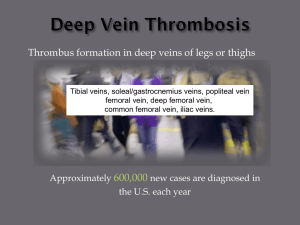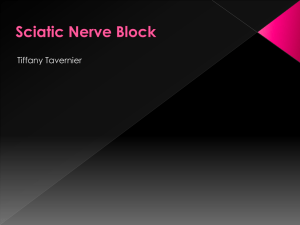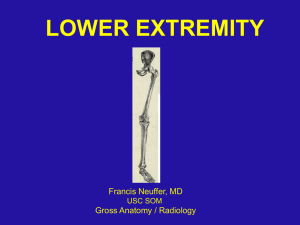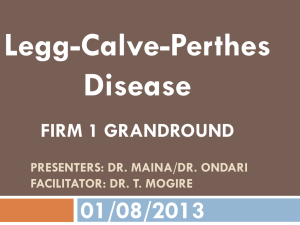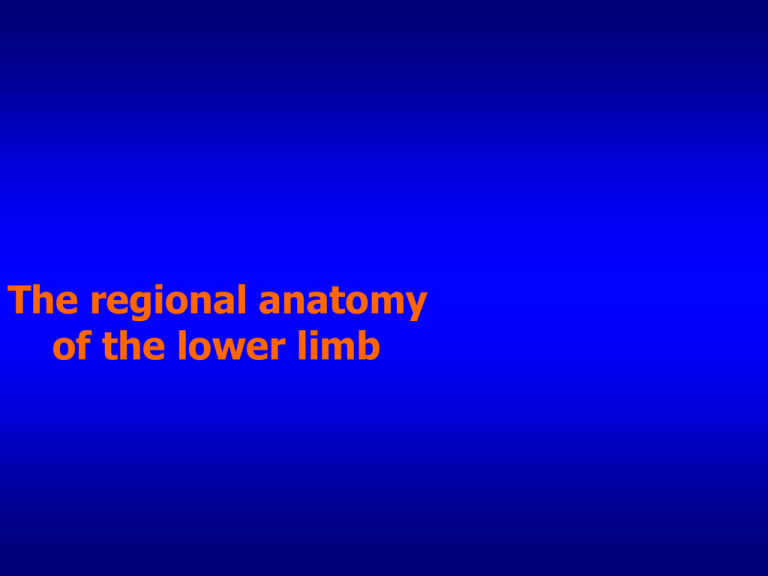
The regional anatomy
of the lower limb
The parts of
the lower limb
(1) By means of the position
The buttock,
the thigh,
the leg,
the foot.
(2) Parts
The thigh: anterior, medial and posterior regions.
Behind the knee: the popliteal fossa.
The leg: anterior, lateral and posterior regions.
The foot: dorsum and sole of foot.
The function
The locomotion and weight bearing.
To support the weight and to make the
erection of the body besides walking and moving
The characteristics of the lower limb
as compared with the upper limb
(1) The thick and large bones
(2) The tough and tensile ligaments
(3) The thick and bulky muscles
(4) The more stabilization of articular movement
I.Surface
Landmarks
1. The iliac crest
(fourth lumber vertebra).
2. The anterior superior iliac spine
3. The posterior superior iliac spine
4. The pubic tubercle
5. The tuberosity of ischium
6. The greater trochanter of the femur
7. The patella
8. The popliteal fossa
9. The medial and lateral
condyles of the femur
10. The medial and lateral
condyles of the tibia
11. The head of the fibula
12. The anterior margin of the tibia
II. The Main Contents
I ) The skin
The skin of the anterior surface is thin,
specially the dorsum.
The skin of the posterior surface is thick,
specially sole of foot.
II ) The superficial fascia
The thickness of the superficial fascia vary
in the different regions.
There are the thickest parts of the
superficial fascia in the buttocks and the
superior part of the posterior region of the
thighs.
The superficial fascia is abundant in the
superficial vein, lymphatic vessel , lymph nodes
and cutaneous nerves.
1.The great saphenous vein
It’s the largest superficial vein of the lower
limb and situated in the anterior and medial parts
of the lower limb.
Begins in the medial side of the dorsum of the
foot →Runs upward anterior to the medial
malleolus → then on the medial surface of the
leg, accompanying with the saphenous nerve
→then ascends on the posteromedial surface of
the knee → runs upwards on the medial surface
of the thigh →inclines anteriorly throngh the
thigh → on the lateral and inferior to the pubic
tubercle enters the femoral vein through the
saphenous hiatus.
It receives five large tributaries, as follow:
(1) The superficial epigastric vein.
(2) The superficial iliac. circumflex vein.
(3) The external pudendal vein.
(4) The superficial medial femoral vein.
(5) The superficial lateral femoral vein.
2. The small saphenous vein
Begins the lateral side of the dorsum of the foot →runs
upward posterior to the
lateral malleolus → then ascends along
the posterior median line of the leg,
accompanying with the sural nerve
→ then passes between the two
heads of gastrocnemius to the lower
part of the popliteal fossa → finally
pierces the popliteal fascia and
drains into the popliteal vein.
It receives a lot of the tributaries and communicates with
the great saphenous vein and deep veins of the lower limb.
3. The superficial inguinal lymph nodes
They are 8-10 in number, lie in the superficial
fascia and are arranged in the shape of “T”.
(1) The upper nodes
They are scattered just
distal to the inguinal ligament
and receive the lymph from
the skin and superficial tissue
of abdominal wall below the
level of the umbilicus, the
buttock, the external genital
organs, the perineum and the
lower part of the anal canal.
(2) The lower nodes
They are placed along both sides of the
upper part of the great saphenous vein and
receive the lymph from the superficial structures
of the lower limb excluding the lateral part of
the foot and the heel.
The efferents of the superficial inguinal
lymph nodes drain into the deep inguinal lymph
nodes.
(1) The anterior and medial regions of the thigh
1)The ilioinguinal nerve
2)The femoral branch
of the genitofemoral nerve
3)The lateral femoral
cutaneous nerve
4)The anterior cutaneous
branchs of femoral nerve
The medial and intermediate
femoral cutaneous nerves
5)The saphenous nerve
(2) The gluteal region, the back of the thigh
and the popliteal fossa
1)The subcostal nerve and the lateral cutaneous
branch of iliohypogastric nerve
2)The posterior branch of the lateral femoral
cutaneous nerve
3)The inferior gluteal cutaneous nerve
4)The superior gluteal cutaneous nerve
5)The middle gluteal cutaneous nerve.
1)The medial sural cutaneous nerve
2)The sural nerve
3)The lateral sural cutaneous
nerve
4)The communicating branch
of peroneal nerve
5)The distal end of the superficial
peroneal nerve
6)The lateral and medial cutaneous
branches of foot.
) The deep fascia
The deep fascia is the compact(dense) and tenacity.
1. In the thigh
The deep fascia of the anterior part of thigh is thick and
called as the fascia lata.
The lateral part of the fascia lata is quite thick and strong,
and extends from the anterior portion of the iliac crest
superiorly to the lateral condyle of the tibia inferiorly, named
the iliotibial tract.
Just inferolateral to the pubic tubercle, there is an oval
deficiency in the fascia, known as the saphenous hiatus.
1. The muscles of the anterior and lateral regions of the thigh
1) The anterior group
The iliopsoas ( the psoas
major iliacus)
The tensor fasciae latae
) The anterior group of the
muscle of thigh
The quadriceps femoris
(rectus femoris,
vastus medialis,
lateralis, intermedius)
The sartorius
3) The medial group
The pectineus,
adductor longus,
gracilis, adductor brevis,
adductor magnus.
3. The muscles
of the leg,
the dorsum of foot
1) The m.of anterior group of the leg
From the medial to the lateral:
tibialis anterior;
extensor hallucis longus;
extensor digitorum longus.
The muscles of lateral group of the leg
peroneus longus;
peroneus brevis.
4) The muscules of
the dorsum of foot
extensor digitorum brevis,
extensor hallucis brevis.
V) The regional structures
1. The lacuna musculorum
and lacuna vasorum
They are the gap and situated between the inguinal
ligament and hip bone. This gap is divided into the Lacuna
musculorum laterally and lacuna vasorum medially by the
iliopectineal arch. They are the passages from the abdomen to
the thigh.
1) lacuna musculorum
The boundary:
anterior----- the inguinal lig.
posteriolateral- the ilium
medial ---- the iliopectineal arch
The contents:
the lateral femoral cutaneous nerve,
the iliopsoas,
the femoral nerve.
2) Lacuna vasorum
The boundaries:
anterior——the inguinal lig. p—— the pectineal lig.
Lateral:the iliopectineal arch, medial :the lacunar
The contents
the femoral artery
the femoral vein
the femoral canal
the lymphatic vessels
2. The femoral triangle
1)The position
The superomedial part of the thigh
2)The formation
The superior boundary:
the inguinal lig.
The lateral boundary:
the medial border of sartorius
The medial boundary:
the medial border of adductor longus
The floor: the iliopsoas, pectineus, adductor longus
The roof: the skin, superficial fascia and deep fascia
The apex: directed downwards and communicates with the
adductor canal
The contents
From the lateral to the medial
The femoral nerve
The femoral sheath:
from the lateral to the medial
femoral artery;
femoral vein;
femoral canal;
deep inguinal lymph nodes
The femoral nerve
It arises from lumber plexus, descends
behind the iliac fascia and the surface of
the iliacus, and enters the femoral triangle
posterior to the inguinal ligament and
lateral to the femoral sheath through
the lacuna musculorum.
The main branch
is short and ends by dividing into a
number of branches 2cm below the
inguinal ligament. Its muscular branches
supply the quadriceps femoris, sartorius and pectineus. Its cutaneous
branches are intermediate, medial femoral cutaneous nerves and the
saphenous nerve. Its articular branches pass to the hip and knee joints.
emoral sheath
It is a funnel shaped fascial
ube which encloses the femoral
rtery, the femoral vein and the
emoral canal formed by the
rolongation of the fascia lining
he abdomen (transverse fascia
nteriorly and iliac fascia
osteriorly).
It ends 4cm inferior to the inguinal ligament and is fused with the
dventitia of the femoral vessels. The sheath is subdivided by two
artitions into three compartments. The lateral compartment contains the
emoral artery; the intermediate one contains the femoral vein; the
medial compartment forms the femoral canal.
★ The femoral artery
It is main trunk of the lower limb.
It is continuous with the external iliac
artery at the mid-inguinal point, then
passes down the femoral triangle and
enters the femoral canal. It becomes
the popliteal artery by passing through
the adductor tendinous opening into the
popliteal fossa.
In addition to three small superficial arteries, the main branch of the
femoral artery is the deep femoral artery which arises from the
posterolateral surface of femoral artery 2-5cm below the inguinal
ligament and gives off the lateral femoral circumflex artery, medial
femoral circumflex artery and 3-4 branches of the perforating artery.
★ The femoral vein
It is medial to the
femoral artery and
receives the tributaries
accompanying the
branches of the
femoral artery.
★ The femoral canal and deep
inguinal lymph nodes
It is a infundibuliform
(funnelform) clearance(space)
about 1-1.5cm long and the
medial compartment of the
femoral sheath.
It is the place of the
susceptibility to the femoral hernia.
● The formation of the femoral canal:
Upper end(femoral ring)------
laterally: the femoral vein
medially: lacuna lig. and
conjoined tendon
anteriorly: inguinal lig.
posteriorly: pectineal lig.
Lower end-------blindness, directing the saphenous hiatus
Wall of the canal------Anterior wall is the fascia lata
Posterior wall is the pectineus fascia
Lateral wall is the femoral vein
● The contents of the femoral canal:
1 to 2 deep inguinal lymph nodes and the
lymphatic vessels; loose areolar tissue and fat.
3. The adductor canal (of Hunter)
(1) Position
It is a deep furrow on the medial side of the middle of
the thigh about 15cm in length.
(2) Formation
Anteriorly: the sartorius and
the adductor lamina;
Laterally: the vastus medialis;
Posteriorly: the adductor longus
and magnus;
Superior opening:
connecting the femoral triangle;
Inferior opening:
connecting the popliteal fossa.
(3)The contents of
The adductor canal
from the anterior to posterior
The saphenous nerve;
The femoral artery;
The femoral vein.
6. The malleolar canal
Position:
It is the medial side
of the ankle joint.
Formation:
It is formed by the flexor retinaculum (which bridges
across the interval between the calcaneus and the medial
malleolus) together with the calcaneus.
The contents of
the mallelar canal:
From the anterior to the posterior
The tendon and
tendinous sheath of the tibialis posterior;
The tendon and
tendinous sheath of the flexor digitorum longus;
The posterior tibial artery
and vein and the tibial nerve;
The tendon and
tendinous sheath of the flexor hallucis longus.

